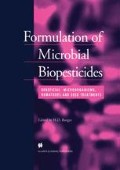Abstract
In this book, key features of organisms and targets for their application have been combined to divide the subject of formulation into nine areas, each served by a chapter. Recurrent themes in these chapters show general trends in the improvement of formulation, and combine to give a good indication of its future. Early research papers investigating potential new organisms usually spoke airily of promising results, often like love affairs between scientists and their science. Further investigations in the harsh reality of field use for pest and disease control made it abundantly obvious that progress in attempts to better the natural performance of the organisms required eventual commercialization of well-formulated products, because most efforts to make organisms available by government and communal projects petered out. Therefore from the earliest stages of investigation the final goal, i.e. potential commercial products, should be kept firmly in view during research design. Although, initially, formulation was neglected, it has since been taken seriously in all subject areas and is well advanced in some.
Access this chapter
Tax calculation will be finalised at checkout
Purchases are for personal use only
Preview
Unable to display preview. Download preview PDF.
References
Anon. (1997) Cautious optimism for biopesticides in the transgenic era. AGROW 274 (February 14), 18–9.
Bateman, R. P., Godonou, I., Kpindu, D. et al. (1992) Development of a novel technique for assessing mycoinsecticide ULV formulations, in Biological Control of Locusts and Grasshoppers (eds C. J. Lomer and C. Prior), CAB International, Wallingford, pp. 255–62.
Begum, H. A. and Jackson, C. W. (1994) Quantitative measurement of avoidance of entomopathogenic fungi by Reticulitermes flavipes Kollar, in Abstracts of the VIth International Colloquium on Invertebrate Pathology and Microbial Control, Montpellier, August–September 1994, Society for Invertebrate Pathology, p. 325.
Bell, A. A. and Wheeler, M. H. (1986) Biosynthesis and functions of fungal melanins. Ann. Rev. Phytopathol. 24,411–51.
Bohmont, B. L. (1990) The Standard Pesticides User’s Guide. Prentice Hall, New Jersey.
Chapple, A. C. and Bateman, R. P. (1997) Application systems for microbial pesticides: necessity not novelty, in Microbial Insecticides: Novelty or Necessity?, BCPC Symposium Proceedings No. 68 (ed. H. F. Evans), British Crop Protection Council, Farnham, pp. 181–90.
Daudi, A. T., Channer, A. G., Ahmed, R. and Gowen, S. R. (1990) Pasteuria penetrans as a biocontrol agent of Meloidogyne javanica in the field in Malawi and in microplots in Pakistan, in Proceedings of the Brighton Crop Protection Conference,Pests and Diseases, Vol. 1, British Crop Protection Council, Farnham, pp. 253–7.
Dent, D. R. (1997) Integrated pest management and microbial insecticides, in Microbial Insecticides: Novelty or Necessity?, BCPC Symposium Proceedings No. 68 (ed. H. F. Evans), British Crop Protection Council, Farnham, pp. 127–38.
Ellis, R. H. (1988) The viability equation, seed viability monographs, and practical advice on seed storage. Seed Sci. Technol. 16,29–50.
Gazzoni, D. L. (1993) Programa de Manejo de Pragas de Soja no Brasil: Uma Abordagem Histórica,Ver-sao, Empresa Brasileira de Pesquisa Agropecuária (EMBRAPA), Centro Nacional de Pesquisa de Soja (CNPSO), Londrino, October 1993.
Jones, K. A. (1988) Studies on the Persistence of Spodoptera littoralis Virus on Cotton in Egypt, PhD thesis, University of Reading.
Jones, K. A. (1994) Registration and use of microbial insecticides in developing countries, in Proceedings of the Vlth International Colloquium on Invertebrate Pathology and Microbial Control, Montpellier, August-September 1994, Society for Invertebrate Pathology, pp. 82–8.
Jones, K. A., Cherry, A. J. and Grzywacz, D. (1996) Use of microbial pesticides in IPM strategies in developing countries, in Abstracts of the 29th Annual Meeting of the Society for Invertebrate Pathology, University of Cordoba, Cordoba, Spain, p. 41.
Jones, K. A. and McKinley, D. L. (1987) Persistence of Spodoptera littoralis nuclear polyhedrosis virus on cotton in Egypt. Asp. Appl. Biol. 14, 323–34.
Jones, K. A., Moawad, G., McKinley, D. L. and Grzywacz, D. (1993a) The effect of natural sunlight on Spodoptera littoralis nuclear polyhedrosis virus. Biol. Sci. Technol. 3, 189–97.
Jones, K. A., Westby, A., Reilly, P. J. A. and Jeger, M. J. (1993b) The exploitation of microorganisms in the developing countries of the tropics, in Exploitation of Microorganisms (ed. D. G. Jones), Chapman & Hall, London, pp. 343–70.
Lisansky, S. G., Quinlan, R. J. and Tassoni, G. (1993) The Bacillus thuringiensis Production Handbook, CPL Scientific, Newbury.
Manasherob, R., Myasnik, M., Ben-Doy, E. et al. (1997) Introduction of Bacillus thuringiensis sub sp. israelensis (-endotoxin genes to the extremely photoresistant bacterium Deinococcus radiodurans R1in Abstracts of the 30th Annual Meeting of the Society for Invertebrate Pathology, Banff, Alberta, P. 45.
McKinley, D. L. (1985) Nuclear polyhedrosis virus of Spodoptera littoralis Boisd. (Lepidoptera, Noctuidae) as an infective agent in its host and related insects. PhD thesis, University of London.
Mugnier, J and Jung, G. (1985) Survival of bacteria and fungi in relation to water activity and the solvent properties of water in biopolymer gels. Appl. Environ. Microbiol 50, 108–14.
Perpetua, N. S., Kubo, Y., Yasuda, N. et al. (1996) Cloning and characterization of a melanin biosynthetic THRI reductase gene essential for appressorial penetration of Colletotrichum lagenarium. Molec. Plant-Microbe Interact. 9, 323–9.
Potts, M. (1994) Desiccation tolerance of prokar-yotes. Microbial Rev. December 1994, 755–805.
Roberts, E. H. and Ellis, R. H. (1989) Water and seed survival. Ann. Bot. 63, 39–52.
Whipps, J. M. and McQuilken, M. P. (1993) Aspects of biocontrol of fungal pathogens, in Exploitation of Microorganisms (ed. D. G. Jones), Chapman & Hall, London, pp. 45–79.
Editor information
Rights and permissions
Copyright information
© 1998 Springer Science+Business Media Dordrecht
About this chapter
Cite this chapter
Burges, H.D., Jones, K.A. (1998). Trends in Formulation of Microorganisms and Future Research Requirements. In: Burges, H.D. (eds) Formulation of Microbial Biopesticides. Springer, Dordrecht. https://doi.org/10.1007/978-94-011-4926-6_10
Download citation
DOI: https://doi.org/10.1007/978-94-011-4926-6_10
Publisher Name: Springer, Dordrecht
Print ISBN: 978-94-010-6066-0
Online ISBN: 978-94-011-4926-6
eBook Packages: Springer Book Archive

